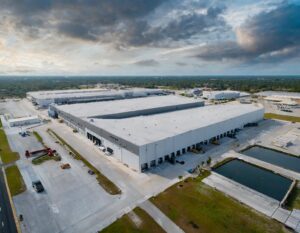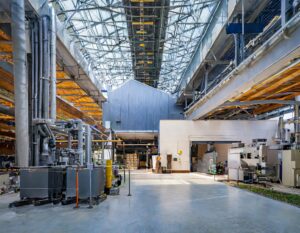Page Contents
- Overview
- Pandemic-Driven Demand Surge
- Record Low Vacancy and Rising Leasing Activity
- Leasing Volume and Deal Trends
- Absorption and Construction Boom
- Submarket Standouts
- Surging Rent Growth in Orlando
- Lease Size Influences Asking Rents
- Rent Trends Across Different Spaces
- Landlord Strategies and Submarket Performance
- Modern Space Fuels Development
- Construction Boom and Preleasing Challenges
- Leasing Trends and Class A Space
- Focal Points of Development Activity
- Lake County’s Rising Developments
- Shift in Investment Environment
- Investment Volume and Cap Rate Trends
- Notable Transactions and Market Slowdown
- Outlook Amid Economic Headwinds
- Closing Thoughts
Overview
- Orlando’s industrial market will expand with 57,000 new residents in 2022, outpacing national growth rates through 2027.
- Central Florida’s industrial vacancy rate at 3.6% remains resilient and below the national average.
- Industrial demand in Orlando is projected to be near 5 million SF by year-end, slightly down from 2022.
- New industrial space deliveries in 2023 will exceed demand, potentially raising vacancy rates.
- Seven major projects over 500,000 SF will add 5.5 million SF to the market, increasing vacancy rates.
- Developers shift focus to mid-sized buildings due to decreased leasing interest in larger projects.
- Tenant interest in spaces over 200,000 SF declines, with minimal activity for spaces over 500,000 SF.
- Orlando’s industrial rent growth ranks eighth nationally in Q1 2023 but is expected to normalize by the end of 2024.
- Investment sales hit $1 billion in the past year, but rising interest rates may slow 2023 activity.
- Orlando’s industrial sector remains strong, adapting to new challenges with robust fundamentals and strategic development shifts.
Pandemic-Driven Demand Surge
Demand for industrial space has soared, driven by logistics, retail, and transportation sectors. The 3.6% vacancy rate signals a tight market, yet 9.8 million SF of new construction promises more leasing opportunities. Despite substantial upcoming space, market fundamentals remain strong, supported by 2022’s robust deal activity.
 Record Low Vacancy and Rising Leasing Activity
Record Low Vacancy and Rising Leasing Activity
Vacancy rates are at a decade-low, spurred by the construction and logistics sectors. Leasing has jumped 35% in three years, with significant deals like Performance Food Group’s 291,875 SF lease. High-quality logistics park spaces attract notable leases, reflecting sustained sector strength.
Leasing Volume and Deal Trends
Though 2022 saw a slight dip in leasing volume and deal numbers, demand for build-to-suit projects remains. Preleasing thrives in smaller bay products, indicating a selective but active market. Despite fewer deals, the demand for premium industrial spaces continues unabated.
Absorption and Construction Boom
A 5.5 million SF net absorption highlights ongoing demand, especially in logistics. The new 9.8 million SF in development, predominantly logistics space, meets this demand. Strong interest from diverse sectors ensures these new spaces will remain open.
Submarket Standouts
SE Orange County, housing a third of Orlando’s industrial space, leads in leasing activity and net absorption, boasting a sub-3% vacancy rate. NW Orange County sees rising demand for distribution parks, promising further growth with extensive construction underway. These submarkets underline Orlando’s industrial strength and future potential.
Surging Rent Growth in Orlando
 Orlando’s industrial rents soared by 15.9%, outpacing the national average due to a 20% rise in industrial employment. This spike in rents, driven by robust leasing activity, is seen as unsustainable, with projections suggesting a slowdown to 13-14% growth by year-end. The tight vacancy and high demand ensure continued rent strength.
Orlando’s industrial rents soared by 15.9%, outpacing the national average due to a 20% rise in industrial employment. This spike in rents, driven by robust leasing activity, is seen as unsustainable, with projections suggesting a slowdown to 13-14% growth by year-end. The tight vacancy and high demand ensure continued rent strength.
Lease Size Influences Asking Rents
Nearly 60 leases over 20,000 SF were signed in 2023, revealing size-based rent trends. Smaller spaces command higher rents, with notable deals demonstrating this variance. Strong interest in spaces under 25,000 SF has minimized concessions, while larger spaces face potential rent pressures due to subdued demand.
Rent Trends Across Different Spaces
Demand remains high for buildings up to 200,000 SF, supporting sustained rent growth in this segment. However, more significant buildings over 500,000 SF face weaker demand, possibly leading landlords to adjust rates. This dynamic suggests a healthy market for mid-sized spaces but challenges for larger distribution centers.
Landlord Strategies and Submarket Performance
Landlords are increasing rents with each new lease, alongside rising escalation rates, reflecting aggressive negotiation strategies. Key submarkets, especially in Orange County, have experienced rent growth of over 15%, buoyed by significant net absorption. This strategy underscores a competitive market with landlords leveraging strong demand to increase rents.
Modern Space Fuels Development
Orlando’s demand for modern distribution and warehouse spaces drives new development, with lower development barriers than South Florida. Abundant land near major routes promises growth, though labor shortages and rising material costs cause delays. Roughly 5.9 million square feet of new space has been completed, with 9.8 million square feet in progress.
Construction Boom and Preleasing Challenges
Orlando sees its highest development in a decade, with 9.8 million SF underway. Despite high construction rates, absorption keeps up. Yet, vacancy rates may rise with five large projects over 500,000 SF soon to be complete and minimal preleasing.
Leasing Trends and Class A Space
Over half of the under-construction space is available, but demand for class-A distribution space remains strong. Leasing activity in 2022 exceeded new supply despite a slight drop, and landlords are adapting to multi-tenant configurations to meet demand.
Focal Points of Development Activity
NW Orange County hosts significant development, including Exeter Property Group’s 1.2 million SF project. Along with Lake County’s new logistics projects, this area underlines Orlando’s growth in industrial space, pushing vacancy rates up but likely matched by continued strong net absorption.
Lake County’s Rising Developments
Lake County sees new industrial projects, like Stonemont Financial Group’s Groveland Central Logistics. These developments, alongside projects by Prologis, Dalfen Industrial, and others, reflect the broader Orlando area’s expanding industrial landscape, accommodating growing logistics and distribution needs.
Shift in Investment Environment
Orlando’s industrial asset prices have soared since the pandemic, but recent Fed rate hikes have cooled the investment climate. Higher interest rates have made debt costlier, affecting deals and investor strategies. Rising cap rates are challenging property valuations, leading to cautious investment approaches.
Investment Volume and Cap Rate Trends
2022 saw 280 industrial sales, totaling $1.0 billion. Despite a national slowdown, Orlando’s market aligns with nationwide averages, with logistics properties dominating sales. High-profile acquisitions, like Prologis’ purchase, highlight the sector’s strength, but a late 2022 slowdown signals changing dynamics.
Notable Transactions and Market Slowdown
Orlando witnessed significant transactions, including a $40.9 million sale of a distribution facility. However, a slowdown in large deals, aside from major acquisitions like Prologis’, indicates a cautious market. High transaction values reflect past solid demand, but current economic conditions are causing a reevaluation of investment strategies.
Outlook Amid Economic Headwinds
Economic challenges and unchanged land pricing expectations may keep investors sidelined into 2023. With the Fed’s rate increases impacting financing, the market faces uncertainty. Investment volume will decrease in the first half of 2023 as the market adjusts to these new conditions.
Closing Thoughts
Orlando’s industrial market has shown resilience and growth despite economic headwinds and changing investment dynamics. Rising interest rates and shifting cap rates influence deal flows and valuations, yet the sector’s fundamentals remain strong, driven by robust demand for logistics and distribution spaces. As the market navigates these challenges, strategic investment approaches and timing will be key. For expert guidance on navigating Orlando’s industrial investment landscape, contact Lumicre for your investment needs.